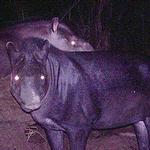 貘是一種保護等級為易危或瀕危的哺乳動物。近日科學家在巴西和哥倫比亞的亞馬遜雨林,發現貘科的新物種Tapirus kabomani,理論發表於當期的「哺乳動物學期刊」(Journal of Mammalogy)。
貘是一種保護等級為易危或瀕危的哺乳動物。近日科學家在巴西和哥倫比亞的亞馬遜雨林,發現貘科的新物種Tapirus kabomani,理論發表於當期的「哺乳動物學期刊」(Journal of Mammalogy)。
科學家以截至目前地理分佈範圍最廣的近緣物種樣本進行比對,提出外觀特徵和DNA證據,以支持他們認為新發現的貘的確屬於新物種的理論。
為了確認Tapirus kabomani的獨特性,研究人員檢查頭骨、組織以及DNA樣本和測量結果。其頭骨形狀及特性和其他還存活的貘種都不同。此外,新種的活動範圍也和其他種不同。和南美貘比起來,毛髮顏色較暗、鬃毛位置較低,額頭也較寬。
新種是目前已知5個貘物種中,體型最小的一種。Tapirus kabomani重約240磅,身長僅4呎,肩高僅3呎,四肢比所有尚未滅絕和部分已滅絕的貘種短。基因研究也顯示Tapirus kabomani和其他貘種有顯著不同。
貘目前存活在東南亞和中南美洲。過去牠們分佈範圍非常廣,但現在各貘種在地理上幾乎都已相互隔絕,並面臨過度狩獵和棲地破壞等威脅。
雖然這是Tapirus kabomani首次被科學命名,但當地人早已知道牠們的存在。當地居民依賴Tapirus kabomani為食,也賦予牠們傳統文化上的地位。研究作者指出,他們和當地居民都見過Tapirus kabomani在草地上和森林中活動留下的痕跡,不過很少親眼在森林或空地見到牠們。
研究作者警告,人口成長、林地減少和亞馬遜地區持續不斷的開發都影響著Tapirus kabomani的生存。「必須立即深入瞭解其保育狀態、地理分布、生存環境需求以及如何被人類活動影響。」作者寫道。
美國的貘研究專家Craig Downer──身兼IUCN物種存續委員會貘專家小組成員與美國哺乳動物學家學會成員身分──極力主張保育新貘種的必要性,因為新貘種很可能有滅絕的危機。
根據Downer2001年在動物學期刊上發表的研究,貘在生態系統中扮演重要的角色,包括傳播許多物種的種子以及讓土壤富含腐植質、維持土壤的健康。「我認為必須立刻針對此新種和其棲息地採取保護措施,從評估其保育狀態、地理分布、棲地條件和對族群以及棲地的威脅開始,同時增加現場的保護設施並教育大眾,才能保護如此重要的物種。」
「新貘種很可能屬於極度瀕危物種,必須被IUCN物種存續委員會貘專家小組和其所在國家列入極度瀕危保護等級,包括哥倫比亞、厄瓜多、祕魯、巴西等,可能還有委內瑞拉和玻利維亞。」Downer說。
A new species of tapir, a mammal considered to be endangered or vulnerable, has been identified by scientists in the Amazon rainforest in parts of Brazil and Colombia. It is the smallest of the five known species of living tapirs.
An article in the current issue of the “Journal of Mammalogy” reports on this discovery. Using the largest geographic sample to date of a related species, the authors provide physical and DNA evidence to support their proposal that the tapirs be classified as a new species, Tapirus kabomani.
To determine the uniqueness of T. kabomani, the authors examined skull, tissue, and DNA samples and measurements. Its skull differs in shape and features from those of all other living tapirs.T. kabomani differs from the other tapir species found in its range, having darker hair, a lower mane, and a broader forehead than Tapirus terrestris.
It weighs about 240 pounds, measures just over four feet in length and three feet high at the shoulder, and it has shorter limbs than all other living, and several extinct, tapir species. Genetic studies also showed distinct results for T. kabomani.
Tapirs currently live in Southeast Asia and Central and South America. Historically, these mammals roamed a wide geographic range, but today’s tapir species are isolated from one another and are suffering from overhunting and habitat destruction.
Although this is the first time T. kabomani has been named scientifically, local people have long known of the species’ existence. They rely on the animals for food and give them a place in their cultural traditions.
The authors report that they and locals have seen significant evidence of this species in grassland and forest habitats, but few tapirs have been seen in areas of pure forest or open ground.
They warn that increasing human population, decreasing forested land, and widespread development in the Amazon could affect the new species.
“It is thus urgent,” the authors write, “to determine the conservation status, geographic range, and environmental requirements of this species, to understand how it is affected by human activities.”
American tapir specialist Craig Downer, a member of the IUCN Species Survival Commission’s Tapir Specialist Group, and a member of the American Society of Mammalogists, urges that conservation measures to protect the new species be taken at once because it is probably in danger of extinction.
“I recommend that immediate conservation measures be taken to protect this species and its habitat, starting with assessing its current population status, geographical distribution, habitat requirements, and threats to both population and habitat, while increasing on-the-ground protection and public education in order to secure a future for this important species.”
“It is very probable that it is in critical danger of extinction and needs to be so classified by the IUCN Species Survival Commission’s Tapir Specialist Group as well as the national governments where it occurs: Colombia, Ecuador, Peru, Brazil, and possibly others such as Venezuela and Bolivia,” he said.
Tapirs play a vital role in the ecosystems they inhabit, including intact seed dispersal of many species and building of healthy, humus-rich soils, wrote Downer in a 2001 article in the “Journal of Zoology.”
※ 全文及圖片詳見:ENS





